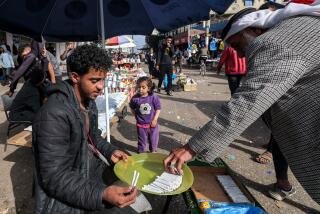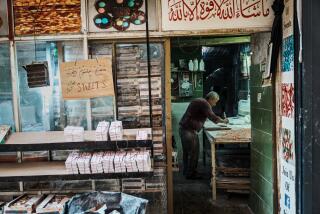Licking Their Wounds
BAGHDAD — Mohammed Saleh is unhappy about his weight. He says he’s even tried dieting because the sizable spare tire he hauls around makes him uncomfortable. “You can see, I am getting fat,” the 50-year-old scientific researcher said, pointing to his belly.
But Saleh also loves his tishreeb, a fatty mutton stew loaded up with meat and bread and rice, followed, of course, by a nap. Nor can he resist what almost always comes next: a visit to his favorite ice cream parlor.
“You see, this is the only way of having fun,” Saleh said as he ate a large cone of soft-serve from a shop on Hurriyah (Liberty) Square.
There is something incongruous about an impoverished “rogue” nation eating ice cream as its most popular pastime--and as a symbol of its perseverance. Yet this simple pleasure has become a reminder of the life Iraqis led before the invasion of Kuwait, and before more than a decade of economic sanctions created a shortage of almost everything, including food and medicine.
Ice cream inspires memories of the golden days of a generation ago, before the eight-year war with Iran in the 1980s, back when there was a real middle class in Baghdad, back when foreigners actually wanted their children to come here to study.
On any given night, Al Faqma ice cream parlor, off Hurriyah Square, is easily the city’s busiest corner. The elite drive by in their fancy (and not so fancy) cars, tooting their horns and stopping at the shops and restaurants that line the road. Al Faqma is an upscale ice cream shop, staffed by a small army of men in white caps and white coats.
It’s easy to find: Just look for the long line. Families and young people, men and women, queue up at the shop window for a cone of soft-serve or a scoop of hard ice cream. The cost is just 250 Iraqi dinars, or about 12 cents, a bargain in this neighborhood.
The corner is buzzing, like Pink’s hot dog stand in Hollywood or any Chuck E. Cheese on a Saturday afternoon. There is even a man with a camera ready to take your picture--for a small fee, of course.
“It is a simple thing for people to enjoy,” said Khalid Ibrahim, 37, who runs the shop with his brother Ismail. “It also helps strengthen social cohesion between the people.”
The infatuation with ice cream springs in part from an Iraqi enthusiasm for fat. Saleh’s concerns about his waistline notwithstanding, the diet and fitness obsession prevalent in the cholesterol-conscious United States is irrelevant here.
Maybe it’s a matter of having more urgent things to worry about, like whether bombs are going to fall on your city again. Or maybe, as some of the snackers at the ice cream parlor said, no one is looking to America for guidance on body shapes.
Maida Mahdi, for one, is fed up with America and doesn’t want the United States, or anyone else for that matter, trying to tell her what to eat. She likes to be a bit, shall we say, full-figured, and she isn’t going to try to slim down for anyone.
Low-fat ice cream? The very concept amuses her. In Iraq, the parlors actually increase the fat content of the ice cream they make when the weather gets hot, which is most of the time. They say it tastes better, and Mahdi won’t have it any other way.
The flavors vary from shop to shop. This particular shop offers vanilla and chocolate soft-serve, and a variety of harder ice creams. Others have only vanilla or chocolate.
“The most important thing for an Iraqi is the belly,” Mahdi, 40, said as she licked a vanilla twist on a sugar cone. “In fact, this is how we enjoy ourselves. . . . We don’t care very much about our weight. We like to eat. We like food with fat.”
In much of the West, Iraq is viewed as an outlaw country, a member of President Bush’s “axis of evil.” President Saddam Hussein is, for the moment, the administration’s most hated head of state. The Mideast nation’s economy has been held captive by nearly 12 years of economic sanctions, imposed after Iraq invaded neighboring Kuwait.
All of this matters to the Iraqi people, although not necessarily because they are concerned with what others think of their country. It just makes it difficult for them to get through their day.
While Washington and Baghdad are busying trying to outmaneuver each other in the blame game (Who really is responsible for the malnutrition and impoverishment that plagues Iraq?), Rabaa Jasim just wants to buy his 7-year-old son, Mohammed, a new pair of shoes. While the United States and Iraq exchange insults and allegations, Sinan Abdulhamid, 20, worries because his family’s savings have been spent so that its members can survive.
Life in Baghdad is, indeed, difficult. Electricity cuts off for hours at a time--which can be torturous in a country where the summers are long and incredibly hot. Like a patient with a spinal cord injury who believes he will walk again, Iraqis are determined to resume a normal life, or at least make the most of the life they have. They remain defiant and insist that someday life will be decent again.
And for now, at least, they can eat ice cream.
“It is something symbolic for us to have ice cream,” said Abdulhamid, a sophomore engineering student at Saddam University and a frequent patron of Al Faqma.
There was a time, not too long ago, when even ice cream was denied Iraqis. When the country became a pariah in the world community in 1990 and was hit with comprehensive economic sanctions for invading its oil-rich neighbor, all of the nation’s ice cream shops were shut down. The country was starving, and the authorities couldn’t afford to allow what little milk and sugar was available to be used for ice cream or other sweets.
After six years of shuttered parlors, the government relented and agreed to an oil-for-food program that allows the sale of crude oil so that food and medicine can be bought and distributed.
The arrangement has been criticized from both sides, with Americans insisting that the sanctions have been too weak in blocking Hussein from rebuilding his weapons of mass destruction program and Iraq insisting that the program is so caught up in bureaucracy that the country is barely able to meet its basic needs.
But oil-for-food meant the ice cream shops did reopen--and that is an important quality-of-life issue, not only in nice Hurriyah Square, but especially in a place like the district of Saddam Hussein City.
With row after row of two- and three-story concrete buildings lined up along dusty roads strewn with trash and debris, Saddam Hussein City is among the poorest neighborhoods.
Fatima Yassin, 52, struggles to come up with the 60,000 dinars (about $30) a month she needs for rent and the 4,000 dinars (about $2) she needs for food each month.
“It is difficult for us to have new clothes,” she said, fingering the threadbare Islamic covering, called a chador, draped over her body.
But Mohammed Tahir still does a good business at his corner ice cream shop in Saddam Hussein City. It is located right next to the food market, an open-air pit where animals are slaughtered next to piles of vegetables and where thick clouds of flies descend on anything that sits still. He sells his cones for just 50 dinars, or about 3 cents.
“Every day I eat ice cream,” said 13-year-old Mohammed Ashur, who stood barefoot in the street. “I get the money from my father every day. He sells fruit in the market every day.”
Mohammed said he wants to grow up to become a military officer because “they are smart and wear nice clothes.” In the meantime, his passion is strawberry ice cream. “That is the best,” he said.
Of course, not all Iraqis are fat. Years of sanctions have created a serious nutrition problem, especially in the southern portion of the country, which in some respects makes Saddam Hussein City look upscale and well-tended. Malnutrition is still a huge problem, and UNICEF’s Baghdad office has warned that any disruption of the distribution of food across Iraq could create chaos “and even famine on a large scale.”
For now, however, Al Faqma is pumping out ice cream in quantities that even Baskin-Robbins might envy. Shop owner Ismail Ibrahim said that in the summer he runs through thousands of gallons of milk a day.
But don’t suggest for a minute that his high-fat ice cream is to blame for anyone’s weight problem.
“In fact,” he said, smiling down at his own tremendous gut, “if you want to be objective, rice is the problem.”
More to Read
Sign up for The Wild
We’ll help you find the best places to hike, bike and run, as well as the perfect silent spots for meditation and yoga.
You may occasionally receive promotional content from the Los Angeles Times.






